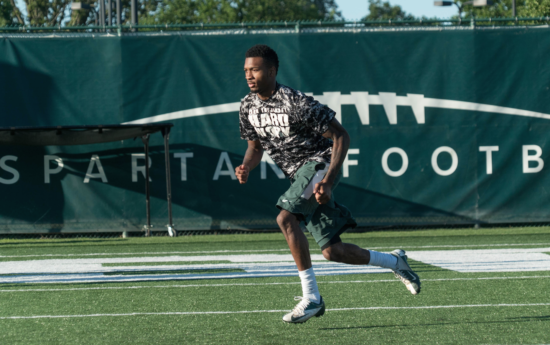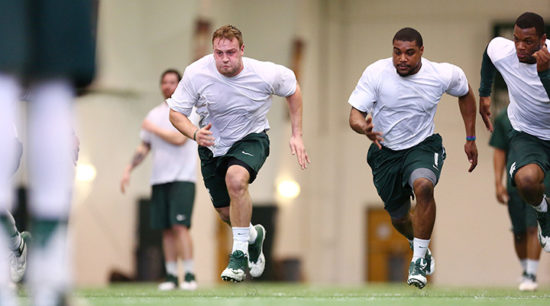Create a conditioning culture during the offseason
Most spring/fall sport coaches are well into their offseason strength and conditioning regimens, and it’s an opportune time to step back momentarily and assess the initial goals set forth by coaches and athletes. Doing this either reaffirms the approach in place or allows enough time to make the needed changes and still achieve the intended results.
 While the pace is usually frenetic this time of year — and the details often seem overwhelming — there are priorities that cannot get lost in the mayhem. Not all of these components are physical in nature.
While the pace is usually frenetic this time of year — and the details often seem overwhelming — there are priorities that cannot get lost in the mayhem. Not all of these components are physical in nature.
The following is our top 10 list — in no particular order of importance — of priorities we set during this period.
1. Maintain a prideful, functional training environment.
Whether you are fortunate enough to have a pristine, state-of-the-art training facility, or have to sweat blood just to set up shop in a renovated boiler room, make the very most of it.
I’ve traveled the entire facility spectrum in a 38-year coaching career. That span encompasses a rudimentary high school space in the mid-1970s, which was equipped with whatever odds and ends we could salvage, to our 16,500 square-foot, multi-million dollar facility here at Michigan State.
In every situation, coaches and athletes worked together for a common cause, used the resources at our disposal to the utmost, dug our proverbial trenches, applied a heavy dose of elbow grease and went to work.
If you’re stuck in what could be perceived to be a dungeon, then make it the best training dungeon in your conference. Clean it, paint it in the school’s colors, emblazon your school’s logo on a wall along with other motivational graphics and furnish it with the safest, best equipment your budget allows.
2. Be assured that the strength program is all-inclusive.
Maintaining period checks on the comprehensive nature of your strength training program is vital. All sports require the entire muscular system — as an interdependent conglomerate of neural, morphological and histological components — be addressed on a consistent, progressive basis. This network includes the muscles of the head/neck, shoulders, chest, upper back, legs (including lower compartments and ankle area) and core (as we define core, this encompasses the entire abdominal area, low back complex, hip complex and the superior aspect of the hamstring origin at the Ischial tuberosity). Place an emphasis on these each of these areas at least two to three times by the end of the training week.
3. Dynamic and static flexibility activities should be a mainstay.
To stretch or not to stretch is often the burning question in athletics. Recommendations on stretching usually are sketchy and sometimes conflicting. While the injury-prevention variable continues to be a conditioning hot potato, most practitioners and clinicians believe that stretching significantly improves flexibility. And, from a performance perspective, improved flexibility — when combined with increased overall strength — heightens power output.
One caveat universally accepted is that a dynamic (or warm-up) period precede any form of static stretching. Dynamics increase blood and oxygen flow to the muscles and increase the internal temperature, which can enhance the elastic properties of connective and muscle tissue. We normally allot three to five minutes for dynamic activities (e.g., movement drills, multi-directional lunges, leg swings against a wall, hurdle step-over/under, etc.) and then follow this with 10 minutes of static stretching utilizing elastic flex bands.
Additionally, a post-stretch period after workouts and practices is highly recommended. In many cases, this stretch proves to be the most effective with the highest degree of carry-over.
4. Address energy system specificity.
Coaches must identify the energy system(s) most engaged by their athletes and specific to their sport, and formulate a training plan for gradual, progressive implementation. Many coaches of fast-paced, explosive, anaerobic sports (i.e., ATP-PC, and ATP-PC/LA energy systems) rightfully are concerned about jumping into their conditioning procedures too soon, too hard, and too much.
We have discussed our base interval format, and I refer you to that piece for suggestions on easing into—and gradually building-up—the conditioning phase of your offseason program. In due time, your athletes should be moving at the appropriate speed and tempo that is expected of them in practices and games.
5. Train for speed independently.
 Speed training is an entity within itself, so address it on an individual basis as often as possible. Quality is far more important than quantity in this process, and never allow fatigue to be a rate-limiting factor. The premise here is that speed training is not a conditioning session, per se. Rather, the focus is on the stance, start, body mechanics, posture, stride length/frequency considerations, and eventual top-speed repeats, with full recovery between all repetitions. Understandably, this format is not always practical, but it should be instituted as such whenever possible.
Speed training is an entity within itself, so address it on an individual basis as often as possible. Quality is far more important than quantity in this process, and never allow fatigue to be a rate-limiting factor. The premise here is that speed training is not a conditioning session, per se. Rather, the focus is on the stance, start, body mechanics, posture, stride length/frequency considerations, and eventual top-speed repeats, with full recovery between all repetitions. Understandably, this format is not always practical, but it should be instituted as such whenever possible.
6. Agility and other change of direction (C.O.D.) drills should be evaluated for effectiveness and transfer.
C.O.D. training often is general in nature, almost relegating it to an ancillary activity. The agility phase may begin with a general layout, but it should eventually evolve into sport- and position-specific requirements. In conjunction with these appropriate, transferable movements, establish a dedicated focus on responding to the key visual and auditory indicators the athletes face in practice and games.
Once the initial segment of “closed-based” drills (e.g., cone agilities, line touches, bag drills and other non-changing, landmark oriented activities) has laid a foundation, the transition to more skill- and sport-specific, “open-based” agility drills — replete with their fast-paced, unpredictable cues — should be put into effect.
7. Document results for progression, safety and liability.
Charting results over the entire duration of the program is essential for tracking improvements, noting stalemates, motivational purposes and possible liability issues that may surface. Documentation speaks to the organization and effective structure of your program. Whether it is done on simple card stock handouts, or through a sophisticated software package, record keeping is a requisite for training success.
Along with the athlete’s name and weekly updated body weight, record the following items for each training session:
- Exercise name and mode.
- Current weight assignment for each set.
- Current rep assignment for each set.
- A box for recording the result of each set.
- A box for recording any special settings (i.e., machine seats, shoulder pad heights, etc.). Note: It is important to keep these settings consistent, as leverage changes affect the exercise difficulty and results.
- A “coach’s comment” box for any needed directives, suggestions, encouraging words, etc.
8. Provide adequate nutritional information and support.
We know fueling the body and the mind helps our athletes perform optimally on the field, in the weight room and in the classroom. And while there is only so much you can do within your resources, everyone can provide guidelines to their athletes to help them achieve peak performance and positively affect their short- and long-term health.
A good starting point is the USDA’s renovated online “Choose My Plate,” which constructs a balanced, healthy, comprehensive approach to dietary guidelines. Every visitor customizes his or her nutritional and fitness plans. Go to www.choosemyplate.gov for an entire menu of nutritional information and suggestions.
9. Account for injured athletes.
Just about every coach in America is working with at least one athlete who is dealing with some type of recently incurred injury — whether it is a minor, easily handled situation, or a more serious post-surgical event that requires an extensive, well-planned rehabilitation protocol. In any case, it is crucial to remember that all athletes are involved in sports due to their magnetic draw to physical activity. Due to this endearment to athletics, being in a non-participatory mode can wreak havoc with an athlete’s psyche when he or she is sidelined with an injury.
This is but one reason why the athlete’s primary care physician, the school’s sports medicine staff, the involved coaches and the athlete’s parents must be actively involved in the entire rehabilitation process. Clearly outline the progressive stages of the rehab protocol for all parties with a clear delineation of who is responsible for the organization, administration and implementation of each phase. Active rehab that is well planned, supervised, charted, and completed with a high level of expertise and great care transcends the physical benefits — it does wonders for the athlete’s mental outlook.
10. Keep the entire coaching staff updated with Continuing Education Units (C.E.U.’s).
Some members of your coaching staff — if not most of them — have little academic acumen in the scientific aspects of strength and conditioning. As such, it is paramount your staff stays actively involved with continuing education activities. These include clinics, seminars, visits with collegiate/professional strength and conditioning coaches and scheduled guest speakers or clinicians who come to your school’s campus for professional growth presentations.
In the current scholastic athletic landscape, everyone is dealing with budget cutbacks and myriad financial issues strapping limitations on these learning opportunities. Offering our student-athletes the safest, most-productive, practical, and effective training methodologies must override those concerns. If we are going to field athletic teams, we owe it to them to do so.
Ken Mannie is the head strength and conditioning coach Michigan State University. His column, Powerline, appears regularly in Coach & Athletic Director magazine.


